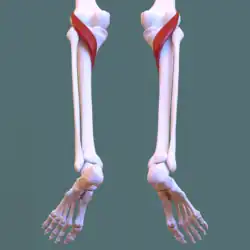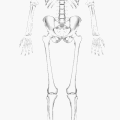Popliteus muscle
| Popliteus muscle | |
|---|---|
 Popliteus muscle (shown in red) | |
Dissection video (2 min 22 s) | |
| Details | |
| Origin | posterior surface of the tibia proximal to the soleus line |
| Insertion | lateral femoral epicondyle |
| Artery | Popliteal artery |
| Nerve | Tibial nerve |
| Actions | Medially rotates tibia on the femur if the femur is fixed (sitting down) or laterally rotates femur on the tibia if tibia is fixed (standing up), unlocks the knee to allow flexion (bending), helps to prevent the forward dislocation of the femur while crouching |
| Identifiers | |
| Latin | Musculus popliteus, poplit=ham (pit) of the knee |
| TA98 | A04.7.02.050 |
| TA2 | 2665 |
| FMA | 22590 |
| Anatomical terms of muscle | |
The popliteus muscle in the leg is used for unlocking the knees when walking, by laterally rotating the femur on the tibia during the closed chain portion of the gait cycle (one with the foot in contact with the ground). In open chain movements (when the involved limb is not in contact with the ground), the popliteus muscle medially rotates the tibia on the femur. It is also used when sitting down and standing up. It is the only muscle in the posterior (back) compartment of the lower leg that acts just on the knee and not on the ankle. The gastrocnemius muscle acts on both joints.
Structure
The popliteus muscle originates from the lateral surface of the lateral condyle of the femur by a rounded tendon.[1] Its fibers pass downward and medially. It inserts onto the posterior surface of tibia, above the soleal line.[1] The muscle arises within the capsule of knee joint and its tendon separates the lateral meniscus from the lateral ligament of the joint.
Nerve supply
The popliteus muscle is supplied by the tibial nerve, from spinal roots L5 and S1.
Variation
There is sometimes an additional head from the sesamoid bone in the lateral (outer) head of the gastrocnemius muscle.
Rarely an additional inconstant muscle; the popliteus minor is seen. It originates from the femur on the inner side of the plantaris muscle and inserts into the posterior ligament of the knee-joint.
Peroneotibialis, 14% of population. Origin is inner side of the head of the fibula, insertion into the upper end of the oblique line of the tibia, it lies beneath the popliteus.[2]
Another variant, the cyamella, is a small sesamoid bone embedded in the tendon of the popliteus muscle. It is rarely seen in humans, but has been described more often in other primates and certain other animals. [3]
Function
The popliteus assists in flexing the leg upon the thigh; when the leg is flexed, it will rotate the tibia inward.
It is especially called into action at the beginning of the act of bending the knee, in as much as it produces the slight inward rotation of the tibia, which is essential in the early stage of this movement.[4]
When the knee is in full extension, the femur slightly medially rotates on the tibia to lock the knee joint in place. Popliteus is often referred to as the "Key" to unlocking the knee since it begins knee flexion by laterally rotating the femur on the tibia.[4]
Popliteus is also attached to the lateral meniscus in the knee and draws it posteriorly during knee flexion to prevent crushing the meniscus between the tibia and femur as the knee flexes.
Additional images
 Animation
Animation Deep layer of muscles on the back of the right leg
Deep layer of muscles on the back of the right leg Muscles of deep posterior compartment of the right leg
Muscles of deep posterior compartment of the right leg
See also
References
![]() This article incorporates text in the public domain from page 484 of the 20th edition of Gray's Anatomy (1918)
This article incorporates text in the public domain from page 484 of the 20th edition of Gray's Anatomy (1918)
- 1 2 Strickland, Justin P.; Fester, Eric W.; Noyes, Frank R. (2017-01-01), Noyes, Frank R.; Barber-Westin, Sue D. (eds.), "2 - Lateral and Posterior Knee Anatomy", Noyes' Knee Disorders: Surgery, Rehabilitation, Clinical Outcomes (Second Edition), Elsevier, pp. 23–35, doi:10.1016/b978-0-323-32903-3.00002-0, ISBN 978-0-323-32903-3, retrieved 2021-03-01
- ↑ Gray, Henry. 1918. Anatomy of the Human Body. Page 485
- ↑ Akansel, Gur; Inan, Nagihan; Sarisoy, H. Tahsin; Anik, Yonca; Akansel, Sertaç (2006). "Popliteus muscle sesamoid bone (Cyamella): Appearance on radiographs, CT and MRI". Surgical and Radiologic Anatomy. 28 (6): 642–645. doi:10.1007/s00276-006-0134-8. PMID 17066262. S2CID 13339926.
- 1 2 Wood, Addison; Boren, Morgan; Dodgen, Taylor; Wagner, Russell; Patterson, Rita M. (March 2020). "Muscular architecture of the popliteus muscle and the basic science implications". The Knee. 27 (2): 308–314. doi:10.1016/j.knee.2019.12.001. ISSN 1873-5800. PMID 31954610.
External links
| Wikimedia Commons has media related to Popliteus muscles. |
- Anatomy photo:15:st-0413 at the SUNY Downstate Medical Center
- PTCentral